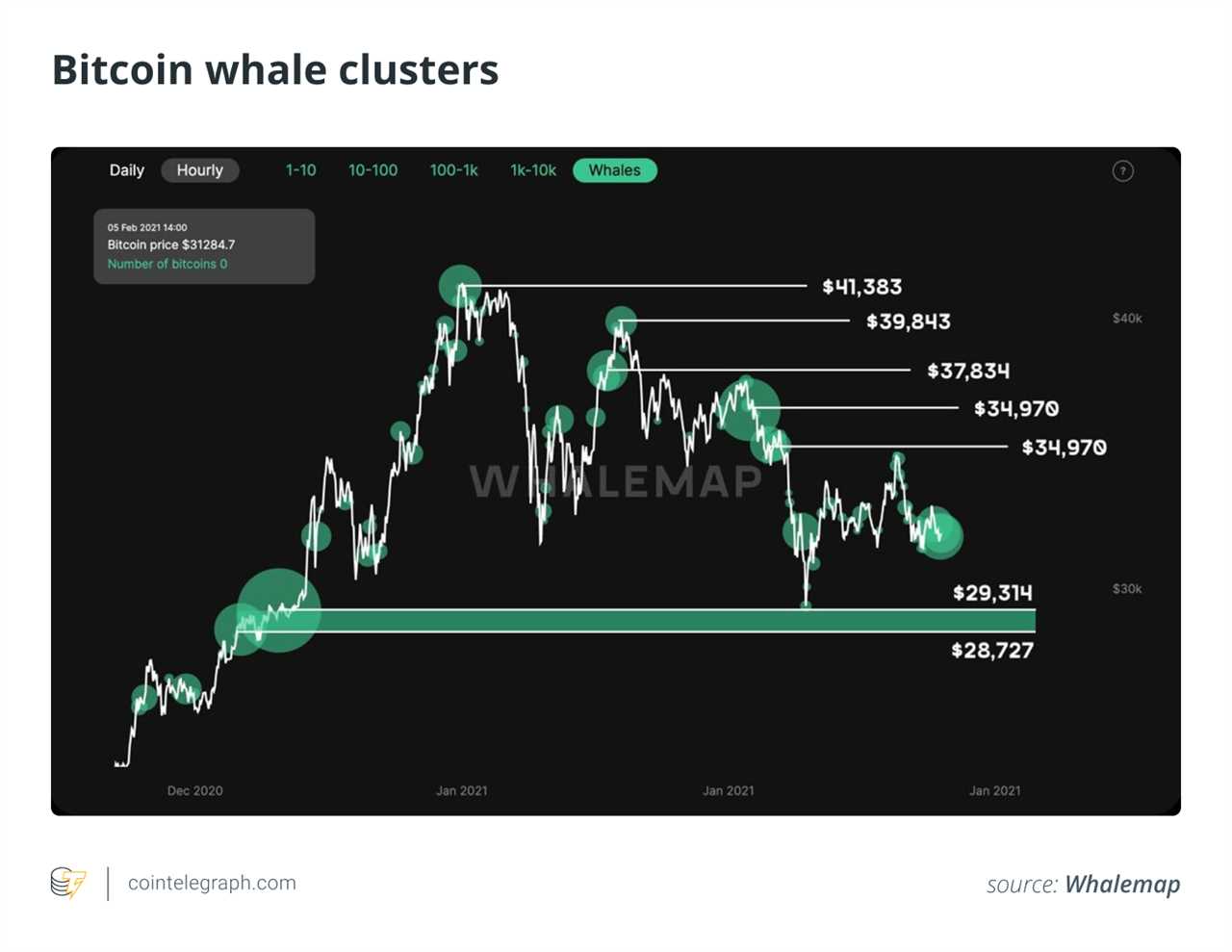
In the past 48 hours, Bitcoin has tested the $30,500 support level on two occasions. Historically, when a major support area is tested repeatedly, it often breaks. On the third retest on Jan. 27, Bitcoin broke below $30,000. However, $30,000 is a highly important support level for BTC, and hence, whales might try to buy the level to prevent a further breakdown after reclaiming it.
Whale clusters suggest three key levels in the near term: $34,970, $29,314 and $28,727. Currently, Bitcoin is battling the $30,000 support level. Whale clusters form when whales or high-net-worth investors buy Bitcoin and do not move it. The theory behind whale clusters is that if BTC pulls back, whales are much more likely to buy more at the price they bought at previously.
The price of Bitcoin (BTC) is consolidating under $33,000 following the steep rejection of $35,000. As BTC stagnates, traders are considering both bear and bull cases in the near term. For now, traders are seemingly leaning toward the bearish scenario as Bitcoin struggles to quickly rebound from the crucial $29,314 support area.

In the foreseeable future, Bitcoin is likely to range between $29,314 and $34,970. Whales that bought BTC at $29,314 will likely keep buying if BTC comes close to that level. But whales that bought at around $35,000 might want to sell at the break-even point, and hence, $34,970 has been acting as a resistance area. Bitcoin has seen two rejections at that level in the past 48 hours, indicating that it’s a stacked sell wall.
BTC bull cases
The bull case for Bitcoin in the short term is still a macro one. In the immediate term, analysts are generally cautious about the trend of Bitcoin. However, in the mid-term to long term, on-chain analysts are spotting a positive trend. According to analysts at Glassnode, the net unrealized profit and loss, or NUPL, indicator shows Bitcoin has room for another rally before topping out.
NUPL measures the level of unrealized profit that crypto investors are sitting on. If the unrealized profit is high, then there is a possibility of a take-profit correction, which can amplify the selling pressure on BTC. Glassnode analysts wrote: “#Bitcoin NUPL was rejected at the entrance into the ‘euphoria’ zone earlier this month. [...] After a similar event in 2017, $BTC increased around 900% before hitting the top.”
Atop the relatively low unrealized profit in the Bitcoin market, institutions and public companies are continuing to accumulate Bitcoin aggressively. On Jan. 25, Marathon, one of the largest enterprise Bitcoin mining companies in North America, bought $150 million worth of Bitcoin.
The company emphasized that it will soon have the capacity to mine 55 to 60 BTC per day, worth $1.65 million. However, the firm noted that it wants to hold more Bitcoin as a treasury asset: “By leveraging our cash on hand to invest in Bitcoin now, we have transformed our potential to be a pure-play investment into a reality.”
The two metrics to watch in the near term will be Coinbase outflows and stablecoin inflows. Coinbase outflows suggest that institutions or high-net-worth investors are buying BTC and taking it off of Coinbase. Throughout the past two months, when outflows have been high, BTC has rallied strongly. High stablecoin inflows are also important because it would mean that sidelined capital is entering back into the Bitcoin market.
BTC bear cases in the near term
The bearish case for Bitcoin in the near term mainly revolves around the prospect of the market seeing a drawdown as a result of institutions and large buyers taking off risk. Raoul Pal, CEO of video channel Real Vision, previously explained the “head fake” theory, where hedge funds and institutions take profits on their positions before the end of the first quarter. This often leads to a marketwide pullback as retail investors that buy stocks and other assets at high valuations begin to capitulate.
Pal said that he feels something is at risk with the market. He pinpointed the abnormal sentiment around gold, Bitcoin, bonds and the U.S. dollar. Based on this trend, Pal said that he is on alert for a “market clearing event,” which likely means a marketwide correction:
“A bit early to tell, but something feels very risky about the markets — how bonds are trading, how the dollar is trading, gold, BTC and what’s been going on in equities. On alert for a market clearing event. Equities are probably the weakest spot.”
Similarly, a pseudonymous trader known as “Altcoin Psycho” said that the options market is set for a huge “gamma squeeze.” If this happens near a record options market expiration date, it could result in a bearish correction in the short term. This trend would go along with the historical tendency of Bitcoin pulling back after the Chinese New Year:
“The crazy thing about $BTC options is we haven’t seen true gamma squeeze yet. Market makers will short calls and retail apes will keep buying, forcing MMs to hedge buy causing gamma squeeze. The real crypto blow off top will be much more parabolic than 2017 because of this IMO.”
Volatility is high
Although some analysts say that the crypto market is at risk of extreme volatility, the same risks that are present in the stock market are not prevalent in the crypto market. For instance, GameStop saw a huge rally overnight as a result of a subreddit’s aggressive accumulation of the stock.
As reported previously, the 700% rise has most likely attracted the attention of the crypto market away from BTC’s performance. Furthermore, Robinhood, a popular trading platform for stocks and crypto, reportedly went down due to high demand for GME.
Quotes in this article taken from previously published sources have been lightly edited.
Title: As Bitcoin price sees sub-$30K, do bears control the BTC market now?
Sourced From: cointelegraph.com/news/as-bitcoin-price-sees-sub-30k-do-bears-control-the-btc-market-now
Published Date: Wed, 27 Jan 2021 16:53:58 +0000
Did you miss our previous article...
https://trendinginthenews.com/crypto-currency/reddit-partners-with-ethereum-foundation-to-boost-scaling-and-resources






